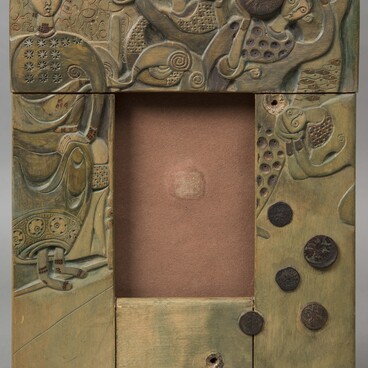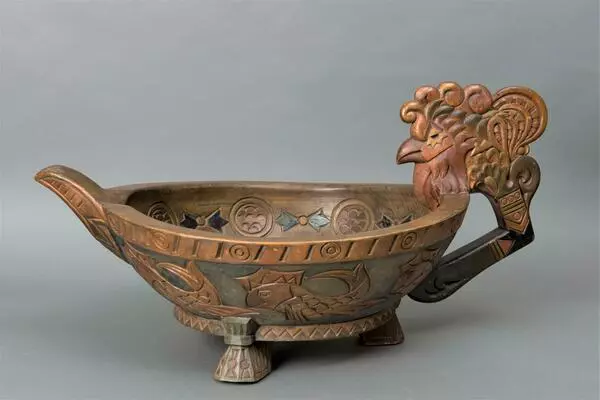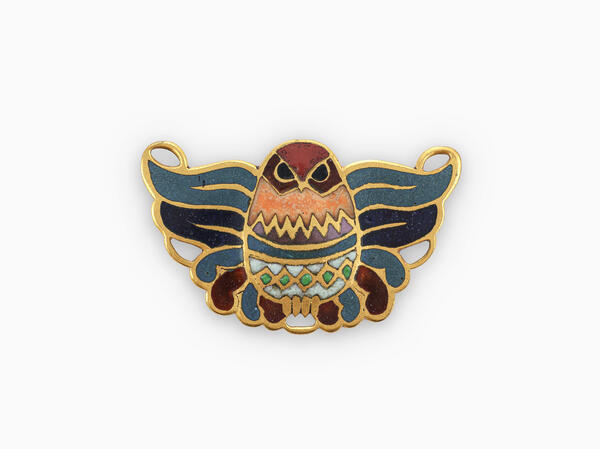A ladle-shaped stand, a household item widespread in the old days, was made in the Talashkino workshops after a drawing by Princess Maria Tenisheva.
In the old days, metal utensils were very rare, and most of the household items were made of wood. Mugs, ladles, loving cups, mortars, bowls, salt shakers — all these were made by Russian carvers. Large cups and ladles were chiseled out from a whole piece of wood. They were decorated with carvings, but they themselves represented a kind of sculptural works. Exotic shapes of ladle-boats and ladle-birds appeared in antiquity.
At the beginning of the 20th century, Talashkino, like Abramtsevo in its time, was the center of Russian artistic life. Tenisheva invited artists to the estate and, with their help, opened educational and art-industrial workshops for the revival of peasant folk art crafts. Painters Nicholas Roerich, Alexander Benois, Mikhail Nesterov, Konstantin Korovin, sculptor Pavel Trubetskoy, composer Igor Stravinsky and others have visited and worked in Talashkino.
When creating workshops in Talashkino, Maria Tenisheva strove to inspire artists not to copy antiquity, but to rethink it creatively. The princess was not only the patron of artists, but she herself was successfully engaged in creativity, including arts and crafts. Items with carving and painting, embroidery and ceramics made by her are well known.
Thanks to Tenisheva’s efforts and research, the art of enamel was revived, the method of making “champlevé” enamel was restored. Her financial support was very significant for the magazine “World of Art” created by Sergei Diaghilev and for many contemporary artists: Ilya Repin, Valentin Serov, Mikhail Vrubel and other prominent figures of Russian art. Princess Tenisheva was also interested in archeology and museum affairs.
In 1919 she left Russia and spent the last years of her life in Saint-Cloud near Paris. But the traditions of Talashkino did not disappear with her departure. The crafts artel miraculously survived, now it is Smolensk Embroidery CJSC. The collection of the Skrynya museum founded by the princess has survived to our time, although some of the exhibits were lost after the revolution.
In the old days, metal utensils were very rare, and most of the household items were made of wood. Mugs, ladles, loving cups, mortars, bowls, salt shakers — all these were made by Russian carvers. Large cups and ladles were chiseled out from a whole piece of wood. They were decorated with carvings, but they themselves represented a kind of sculptural works. Exotic shapes of ladle-boats and ladle-birds appeared in antiquity.
At the beginning of the 20th century, Talashkino, like Abramtsevo in its time, was the center of Russian artistic life. Tenisheva invited artists to the estate and, with their help, opened educational and art-industrial workshops for the revival of peasant folk art crafts. Painters Nicholas Roerich, Alexander Benois, Mikhail Nesterov, Konstantin Korovin, sculptor Pavel Trubetskoy, composer Igor Stravinsky and others have visited and worked in Talashkino.
When creating workshops in Talashkino, Maria Tenisheva strove to inspire artists not to copy antiquity, but to rethink it creatively. The princess was not only the patron of artists, but she herself was successfully engaged in creativity, including arts and crafts. Items with carving and painting, embroidery and ceramics made by her are well known.
Thanks to Tenisheva’s efforts and research, the art of enamel was revived, the method of making “champlevé” enamel was restored. Her financial support was very significant for the magazine “World of Art” created by Sergei Diaghilev and for many contemporary artists: Ilya Repin, Valentin Serov, Mikhail Vrubel and other prominent figures of Russian art. Princess Tenisheva was also interested in archeology and museum affairs.
In 1919 she left Russia and spent the last years of her life in Saint-Cloud near Paris. But the traditions of Talashkino did not disappear with her departure. The crafts artel miraculously survived, now it is Smolensk Embroidery CJSC. The collection of the Skrynya museum founded by the princess has survived to our time, although some of the exhibits were lost after the revolution.




